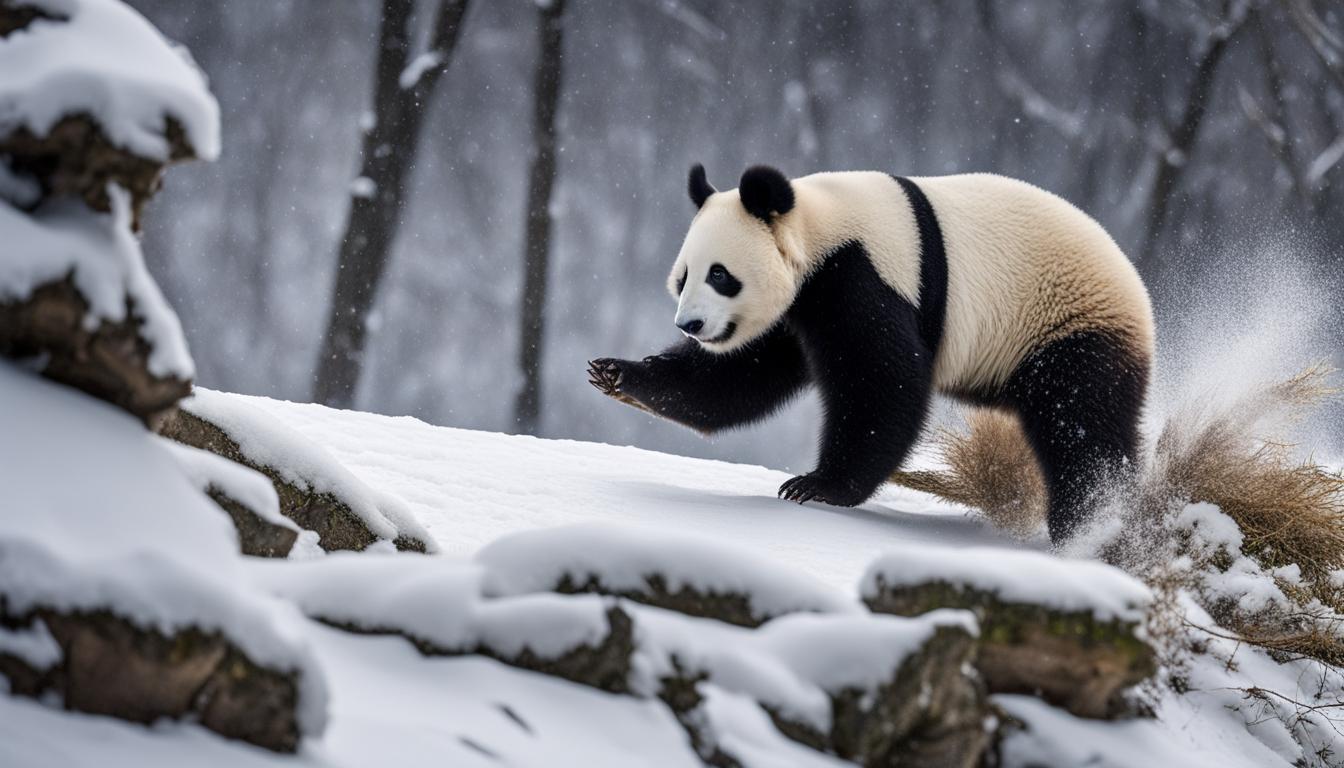If you’ve ever wondered how giant pandas survive the chilly winter months, you’re in for a treat. These adorable creatures have some fascinating behaviors and adaptations that help them thrive in cold conditions. In this article, we’ll explore panda winter behavior, hibernation patterns, and their incredible adaptations to winter.
Panda Winter Survival Strategies
During the winter months, giant pandas exhibit unique strategies to survive in cold weather conditions. These adaptations enable them to thrive in their mountainous habitats and continue their daily activities. Let’s explore some of the fascinating behaviors and habits of pandas in winter.
Behavioral Adaptations
Pandas rely on bamboo stalks as their primary food source, even during the winter. However, they have been observed avoiding the consumption of bamboo leaves, which have lower protein content in the colder months. Instead, pandas focus on eating the nutrient-rich bamboo stems to sustain themselves through the winter.
Pandas also exhibit interesting behavior by stretching out with their bellies up, a posture that easily loses heat. This behavior suggests their preference for colder temperatures. Unlike other mammals on the zoo’s Asia Trail, pandas do not have access to heated rocks and actually prefer colder environments for their well-being and comfort.
Hibernation Patterns
Unlike many other bears that hibernate during the winter, giant pandas do not undergo a true hibernation period. Instead, they remain active throughout the year, including the colder months. This lack of hibernation is due to their unique metabolic system, which helps them conserve energy and maintain their body temperature even in cold conditions.
While pandas do not hibernate, they do exhibit reduced activity during the winter. They conserve energy by minimizing unnecessary movements and maintaining a slower pace of life. This allows them to cope with the limited food availability and harsh weather conditions during the winter season.
| Winter Habits | Temperature Preference |
|---|---|
| Pandas rely on bamboo stalks as their primary food source, consuming the nutrient-rich stems while avoiding the leaves. | Pandas prefer colder temperatures and have been observed stretching out with their bellies up to lose heat. |
| Pandas exhibit reduced activity during the winter to conserve energy. | Pandas thrive in habitats with temperatures around 64-69°F. |
As we delve into the winter survival strategies of giant pandas, it becomes clear that they have evolved remarkable adaptations to withstand cold temperatures. Their behavioral and metabolic adaptations allow them to sustain themselves and remain active throughout the winter months. By understanding these incredible creatures’ ability to adapt to challenging environments, we can further appreciate the importance of conservation efforts to protect and preserve these magnificent pandas for generations to come.
Winter activities of pandas
Despite the cold weather, pandas can be quite active during the winter months. In fact, visitors to the National Zoo have reported seeing pandas at their liveliest on the coldest days. Pandas are known to enjoy playing in the snow, which adds an extra element of excitement to their winter routine. Their playful behavior is a testament to their adaptability and resilience in chilly conditions.
Pandas love rolling around in the snow, creating adorable snow pandas in the process. They slide down hills, make snow angels, and engage in friendly wrestling matches. These activities not only provide entertainment but also serve as a form of exercise for the pandas. It helps them stay active and maintain their physical fitness during the winter months when food sources may be scarce.
While pandas may not hibernate, they do spend a significant amount of time resting and conserving energy during the winter. After a playful session in the snow, pandas often find a cozy spot where they can curl up and take a nap. This downtime allows them to recharge and conserve energy for their next bout of winter activities.
Quotes:
“Watching pandas play in the snow is such a joyous experience. They seem to have so much fun and it’s infectious!” – Zoo visitor
“I never knew pandas could be so active in the winter. It’s fascinating to see how they adapt to the cold weather.” – Wildlife enthusiast
| Winter Activities | Description |
|---|---|
| Rolling in the snow | Pandas love to roll around in the snow, creating adorable snow pandas. |
| Sliding down hills | Pandas slide down hills, enjoying the thrill of the snowy slopes. |
| Making snow angels | Pandas lie on their backs and flap their arms and legs to make snow angels. |
| Wrestling matches | Pandas engage in friendly wrestling matches, showing off their strength and agility. |
As you can see, pandas are not discouraged by the cold winter weather. They embrace the snow and use it as an opportunity for play and exercise. These winter activities not only provide entertainment for pandas and visitors alike but also contribute to their overall well-being. It’s truly amazing to witness their adaptability, resilience, and sheer joy in the face of chilly conditions.
Panda adaptations to cold temperatures
Giant pandas have evolved remarkable adaptations to cope with the cold temperatures in their mountainous habitats. One of their key adaptations is their thick fur, which provides insulation and helps them stay warm in low temperatures. The dense fur acts as a natural barrier, trapping their body heat and protecting them from the cold winter conditions. It also helps them conserve energy by reducing heat loss.
In addition to their fur, pandas have a unique metabolic system that further aids in their adaptation to cold temperatures. They have the ability to lower their metabolic rate, allowing them to conserve energy during winter when food is scarce. By slowing down their metabolism, pandas can maintain their body temperature and survive for extended periods without needing to eat as frequently. This adaptation is crucial for their survival in the cold winter months.
Furthermore, pandas exhibit behavioral adaptations to cope with cold temperatures. While they do not hibernate like other temperate-climate bears, they do modify their behavior in response to winter conditions. Pandas are known to climb to lower altitudes in search of warmer temperatures. By moving to areas with milder climates, they can find relief from the extreme cold and conserve energy.
Panda Adaptations to Cold Temperatures
To summarize, pandas have several adaptations that enable them to thrive in cold temperatures. Their thick fur provides insulation and reduces heat loss, their unique metabolic system helps them conserve energy, and their behavioral adaptations allow them to seek out warmer areas during winter. These adaptations work together to ensure the survival and well-being of pandas in their challenging mountain habitats.
| Adaptation | Description |
|---|---|
| Thick Fur | Provides insulation and reduces heat loss. |
| Unique Metabolic System | Allows pandas to lower their metabolic rate and conserve energy. |
| Behavioral Adaptations | Pandas climb to lower altitudes for milder temperatures and energy conservation. |
Overall, the adaptations of pandas to cold temperatures demonstrate their incredible ability to survive and thrive in challenging winter conditions. These adaptations are essential for their survival and highlight the remarkable resilience of these beloved creatures.
Conclusion
Giant pandas possess incredible adaptations that enable them to thrive in winter conditions. With their thick fur, behavioral adjustments, and unique metabolic system, these marvelous creatures are well-equipped to stay warm and conserve energy during the colder months.
Unlike other temperate-climate bears, pandas do not hibernate, but instead remain active throughout winter. Their preference for lower altitudes helps them find warmer temperatures, while their thick fur acts as insulation against the cold. Moreover, pandas have a remarkable ability to regulate their metabolic system, allowing them to maintain their body temperature and conserve energy in cold temperatures.
Interestingly, pandas exhibit playful behavior even in the midst of winter. Visitors to the National Zoo often witness their liveliness on the coldest days, with pandas frolicking in the snow. Their adaptability and resilience in chilly conditions are truly awe-inspiring.
By understanding the fascinating winter behaviors and adaptations of pandas, we gain a deeper appreciation for their ability to adapt to challenging environments. It also highlights the importance of conserving and protecting these magnificent creatures and their habitats, ensuring their continued survival for generations to come.
How do Winter Conditions in Giant Pandas’ Habitats Compare to the Effects of Climate Change on Them?
Winter conditions in giant pandas’ habitats play a crucial role in their survival. However, climate change poses a significant threat to these species, affecting their food sources and overall habitat. As temperatures shift and extreme weather patterns become more frequent, giant pandas and climate change are a concerning combination for their long-term well-being.
FAQ
How do giant pandas adapt to winter conditions in their habitats?
Giant pandas adapt to winter conditions by using their thick fur to stay warm in low temperatures. They also climb to lower altitudes in the winter to find warmer temperatures. Unlike other temperate-climate bears, pandas do not hibernate and remain active throughout the winter.
What are panda winter survival strategies?
Panda winter survival strategies include relying on bamboo stalks as their main food source and avoiding eating leaves, which have diminished protein content in the cold months. Pandas have also been observed stretching out with their bellies up to lose heat, indicating their preference for colder temperatures. They do not have access to heated rocks like other mammals on the zoo’s Asia Trail and actually prefer colder environments.
What are the winter activities of pandas?
Pandas can be quite active during winter months. They are known to enjoy playing in the snow, which adds an extra element of excitement to their winter routine. Visitors to the National Zoo have reported seeing pandas at their liveliest on the coldest days.
What are panda adaptations to cold temperatures?
Panda adaptations to cold temperatures include their thick fur, which provides insulation, and their unique metabolic system that helps conserve energy. These adaptations enable pandas to maintain their body temperature and conserve energy while enduring colder conditions in their mountainous habitats.
What can we learn from the behaviors and adaptations of pandas in winter?
By understanding the fascinating behaviors and adaptations of pandas in winter, we can appreciate their ability to adapt to challenging environments. This knowledge can also increase efforts to conserve these magnificent creatures and their habitats.











